Audiovisual communities as producers of hate subjectivities. Digital Governmentality, technopopulisms and violence in Mexico.
Abstract
In the first decade of the twentieth century, social networks were integrated into electoral campaigns giving rise to audiovisual communities capable of functioning as a means of communication that manufactures and promotes the approach of candidates with a new narrative of constituting a networked multimedia citizenship. However, the dissemination of the public image can be questioned in the face of an authoritarian digital governmentality regime that makes use of violence as an instrument that promotes a policy of fear and terror. This research note seeks to answer how social networks produce hate subjectivities, and in turn, the risk of materializing in the execution of political violence in the context of electoral campaigns during the year 2021 in Mexico. Based on the analysis of the impact of the political discourse of a federal deputy on the subsequent murder of a mayor in a municipality in the State of Oaxaca I will discuss: the scope of technopopulism, the desire for visibility and its influence on voters in producing hate subjectivities. Using Twitter -now knows as X- as a source of big data, I will explore online conversations as a qualitative methodology that generates knowledge from empirical virtual reality.
Keywords: audiovisual communities; hate subjectivities; digital governmentality; technopopulism; violence.
Comunidades audiovisuales como productoras de subjetividades de odio. Gubernamentalidad digital, tecnopopulismo y violencia en México.
Resumen
En la primera década del siglo XX, las redes sociales fueron integradas dentro de las campañas electorales dando auge a comunidades audiovisuales capaces de funcionar como un medio de comunicación que fabrica y promueve el acercamiento de los candidatos con nuevas narrativas de construir una ciudadanía multimedia en red. Sin embargo, la difusión de la imagen pública podría ser cuestionada ante un régimen de gubernamentalidad digital que hace uso de la violencia como instrumento que incita a una política de miedo y terror. Esta nota de investigación busca conocer cómo las redes sociales producen subjetividades de odio, y a su vez, el riesgo de materializarse en la ejecución de la violencia política en el contexto de las campañas electorales de 2021 en México. Partiendo del análisis del impacto del discurso político de un diputado federal sobre el asesinato de un alcalde en un municipio del Estado de Oaxaca, discutiré: el alcance del tecnopopulismo, el deseo de visibilidad y su influencia en los votantes para producir subjetividades de odio. Usando Twitter como fuente de big data exploraré las conversaciones online como metodología cualitativa para generar conocimiento a partir de la realidad empírica virtual.
Palabras claves: comunidades audiovisuales; subjetividades de odio; gubernamentalidad digital; tecnopopulismo; violencia.
------------------------------
Urbieta Hernández Roque
Docteur
Mondes Américains, Ecole des Hautes Études en Sciences Sociales, París, France & Autonomous University of Madrid, Spain
Cette adresse e-mail est protégée contre les robots spammeurs. Vous devez activer le JavaScript pour la visualiser.
Audiovisual communities as producers of hate subjectivities. Digital Governmentality, technopopulisms and violence in Mexico
« Ce qui définit essentiellement un système métastable, c’est l’existence d’une “disparation”, au moins de deux ordres de grandeur, de deux échelles de réalité disparates, entre lesquels il n’y a pas encore de communication interactive » (Deleuze , 2002).
« Je pense qu’il en est de même dans le domaine politique avec Twitter. Les hommes politiques qui tweetent, c’est la rapidité, c’est la continuité du fil qui efface ou recouvre d’une opacité pratique les tweets anciens, et permet finalement de tout oublier. [Toutefois] rien n’est pardonné et tout est toujours oublié. Le rôle du pardon est aujourd’hui tenu par l’oubli, et c’est peut-être beaucoup plus vrai aujourd’hui qu’avant : on pense qu’on retient tout, que la mémoire numérique est cumulative » (Antoinette Rouvroy, 2015)
Introduction
"My sources tell me that the parting mayor [Leobardo Ramos Lázaro] here in Chahuites arrived poor, without a house, and that he already has three houses worth more than a million pesos. He arrived without a mango tree and now he has hectares, without a car, and then…What the fuck are all of you doing, are you all asleep, asleep, asleep? Or what happened? This bastard is stealing and stealing. They tell me he is violent, that he is a mafioso, that he is vindictive. I'm going to ask you a tough question: How many balls does the Mayor have? I think he has two, right? Or does the bastard have more? Two, four, eight, ten? And you fellow men, fellow women, what are you doing? Because women, when they make up their minds, are very firm, and not to mention the Isthmian women. We have to squeeze the bastard Mayor, here squeezed. There are many places where they don't understand, sometimes even their colleagues, that this has changed, that they won't put up with the corruption of anyone. And then they continue to do their thing, and I frankly think that the time will come when the houses that are badly taken over will be taken over by the people to make them into Cultural Centers, Sports Centers, Social Centers, Health Care Centers to recover what belongs to the people and put it at the service of the people" (Fernando Fernández Noroña, Federal Deputy for Partido del Trabajo, 01/31/2021).
These were the words recovered from the public meeting held on January 31, 2021 by Federal Deputy Fernando Fernández Noroña representing the Partido del Trabajo (PT), with inhabitants of the municipality of Chahuites[1], located in the southwest of the State of Oaxaca five months before the municipal elections and the renewal of the Chamber of Deputies in the country. Four days after this historic event, on board his truck, the then- mayor, Leobardo Ramos Lázaro, was intercepted by three individuals who blocked his path with their motorcycles and killed him with firearms. So far, the perpetrators of this unofficial execution have not been captured[2]. After the fourth of February of that year, the politician Fernando Noroña became a trending topic in social networks, where users pointed him out as the main promoter of “hate” and “violence”. In addition, the event appeared in the national political debate and in the media because of the importance of a federal deputy producing a message of “socio-digital lynching” against the Oaxacan Mayor.
The assassination of the mayor of Chahuites, Oaxaca has the characteristics of the political violence that accompanied the electoral processes five months before the June 2021 elections. In this locality, the municipal authority was to be renewed. In fact, the visit of the federal deputy Fernando Fernández Noroña was part of the political proselytism of the then-candidate of the Partido del Trabajo.
In this sense, this research note aims to understand how social networks produce hate subjectivities from political discourse, and their transcendence from the virtual community to social reality through the activation of political violence in a context of electoral campaigns. This case study allows me to argue that the power of messages produced in the network society is a continuum of longue durée structural violence reproduced in the regime of digital governmentality, being the politics of fear and terror characteristic of socio-virtual communities in environments of hegemonic struggles for the control of ideological violence.
To this end, the rise of a multimedia citizenship is key to perceive the existence of a "network of interconnected actors" who instrumentalize audiovisual communities as a means of participation in the creation of information through the production of hate subjectivities and, at the same time, their dissemination in "diffuse conversations" (Boyd, Golder and Lotan, 2010). Multimedia citizenship validates and legitimizes longue durée structural violence in this new regime of "digital governmentality" (Rouvroy and Berns, 2013).
Thus, technopopulism, understood as a resource that operates as a "testimonial image"[3] appealing to "science", "people" and "emotions", (De la Torre, 2018; Bickerton y Invernizzi 2021) manipulates multimedia citizenship to lead them to intervene in the network society through the practice of political violence by executing the "enemy" in historical moments of power metamorphosis. Hence, the assassination of the mayor is interpreted as a practice of multimedia citizenship that acts as a means of co-participation between technopopulism and imagined digital communities.
Therefore, I ask myself, what is the scope of technopopulism in the desire for visibility through the promotion of hate speech and violence as a political campaign strategy? How are hate subjectivities produced and how do they transit from social reality to virtual reality and what is their impact on the transformation of social reality? Is the murder of the mayor the realization of the "popular will" promoted by technopopopulism?
It is within the scope of this research note to reveal the "digital inequality" in Mexico and its use as a "social gap" between class groups differentiated according to geographical areas, Twitter (now known as X) being a medium that marks this economic stratification. Following the seventeenth study on the habits of Internet users in Mexico 2021 of the Internet Association MX points out that derived from the year of COVID-19 confinement the activities related to tele-education and tele-work increased the general knowledge of users about the different forms of access to communication applications. The research showed that 86.8% of the users had access to social networks through a smartphone, although some users faced limitations "because they have low-end devices", which favored the popularity of WhatsApp (97.1%) and Facebook (94.8%) as the main means of interaction among Internet users. While Twitter was used by 62.9%, it was only behind YouTube (93.7%) and Instagram (78.3%).
The paper is structured as follows. 1). Twitter as a generator of knowledge; 2). Technopopulism as a testimonial image in the production of hate subjectivities; 3) Multimedia citizenship as a means of participation in the creation and dissemination of the desire for visibility; and 4) The politics of terror, fear and death as characterizations of political violence. This research note finally contributes to show the production of knowledge generated on the basis of big data in the framework of the study of the scope of technopopulism and social networks as a source of manipulation. Additionally, the ethics in political communication derives its influence on multimedia citizenship through the detonation of the murder of a political subject as part of a strategy in the desire for media visibility in the era 2.0.
I. Twitter as a source of methodological knowledge
The methodology acquires a double qualitative scope by using two different media as units of analysis. In the following, I will describe the combination of video broadcast on YouTube and Twitter as empirical evidence of media that transmit in the same language. That is text, audio and image within the same method. At first glance, the source of enunciation where the technopopulist subject emerges in the network society and its narrative construction from the use of technology by the multimedia citizenry, specifically, the capture of political discourse through video. The video was uploaded on the YouTube channel and has a total duration of 29 minutes and 57 seconds[4]. This item focuses on the 2 minutes and 36 seconds (from minute 16:00 to 18:36) dedicated to describe the 'corrupt' personality of the then-mayor of Chahuites.
Based on the analysis of political performance as a method and its impact on social reality, we could come closer to affirming that the effect of the discursive elaboration of the “people” and the appropriation of “technology” as components of technopopulism in the era of digital governmentality led to their murder four days later. Therefore, the importance of the examination of this event as an instrument of content analysis of the multimedia object and the qualitative data produced on Twitter in the light of the beginning of the electoral campaigns.
It should be emphasized that this research note is an approach to the construction of the techno-populist concept associated with the creation of a method dedicated on the analysis of social networks. Therefore, for this writing, I have chosen only the news about the murder of the former mayor of Chahuites, concentrating on the socialization of user conversations in twitter. Also in the position of Fernando Noroña and the reaction of multimedia citizens to identify key words that would give me space to study the impact of violence due to technopopulism in times of electoral campaigns.
On the other hand, I will research the data of online conversations (data-mining) created by users on social networks from February 4 to February 10, 2021.During this period the public figure of Fernando Noroña was consolidated as a trending topic reaching the number five position nationally, exposing him as the principle responsible for producing a "discourse of hate and violence" against the mayor murdered in Chahuites. In fact, this document resorted to identify the hashtag #NoroñaAsesino.
In the same way, the keywords "hate" and "violence" as the main hard data of the text messages produced by communicating objects in the tweets where @FernandoNorona was named. Hence, I will show with this research, the passage from a deductive logic to an inductive logic of networked messages as means of interaction with speed, data capacity and complexity of thoughts (Boyd, 2015). To illustrate this paper, the tweets were selected according to the number of followers analyzing the online interactions and their influence in fabricating a negative public image of Fernando Noroña in the environment of the network society and political communication.
II. Technopopulisms in the digital governmentality regime
Technopopulism originates from the presence of two political categories that emerge within a new digital governmental regime in contemporary democratic societies. While the first one refers to skill and expertise in science; the second one appeals to the discursive construction of "people", therefore, it possesses the right to represent the "popular will" through the manipulation of "emotions". Populism appears where the image and charisma of the leader are a means of connection with the citizenry (Urbieta, 2023).
Technopopulism erodes the foundations of popular representation by seeking new forms of political intermediation. Therefore, technology becomes a contact zone between the populist leader and the citizenry through the production of multimedia. Technopopulism directs its "wrath" towards the same target as professional politicians and political parties, positioning itself as self-referential actor (Bickerton and Invernizzi, 2021; De la Torre, 2013). Hence, one of its characteristics is the toxicity of political language.
In the video that circulated on January 31, 2021, I observe a political actor complying with the traditional norms that characterize the personality of a technopopulist who, using himself as a representative of the popular will, "advises" a community of citizens based on his experience, to "squeeze the bastard Mayor" referring to Leobardo Ramos. Using a media structure and technological means such as the cell phone, a multimedia citizenship emerges in order to capture the technopopulist subject and expose him to the virtual community. Technopopulism tends to lead these trends through social networks, hence attracting the attention of the traditional media. Multimedia citizenship, thanks to the viralization of Fernando Noroña's speech, exposed the potential of offering technology for its emancipation. Although in the process, multimedia citizenship reproduces violence on a digital and material scale.
Therefore, technopopulism acquires a logic of popular will in a technosocial enclave where multimedia citizenship is the actor-network that creates information and validates the rise of hate subjectivities and violence. Thus, attending to the constructed discourse of "people" and materialized in the "popular will" through the murder of the mayor, I am pointing out the power of technopopulism in a new digital governmental regime.
According to Antoinette Rouvroy and Thomas Berns in the regime of digital governmentality "each subject is himself a multitude, but he is a multitude without otherness, fragmented in a number of profiles who all relate to each other, in their propensities, their presumed desires, their opportunities and their risks" (2013: 192). Then, multimedia citizenship is the subject in question within digital governmentality considering that its positioning in the network space is that of an intermediary between technology and the connected actors, hence building knowledge from the data related to the audiovisual communities.
In the case of the social network Twitter, the medium acquires a technological spatial range associated with "producing meanings" in which the multimedia citizenry creates information and circulates it, originating an effect of subversion and resistance against "a hierarchical model" in an "oppressive society". Authoritarianism is not only a political action institutionalized by those subjects who monopolize the right to kill but is embodied in the heart of the "people". The effect of technopopulism on a popular representative exhibits the singling out of "corrupt elites" as enemies of the people.
On the contrary, I observe the appropriation of the discourse of "people" in the technological tools to denounce and be both technopopulism and multimedia citizenship protagonists of giving continuity to a longue durée structural violence. With digital governmentality, this experience of "emancipated forms of life" in the network society is propitiated. The capture of the video by the multimedia citizenship of Fernando Fernández Noroña's political discourse and performance exemplifies its existence and denunciation before the international audiovisual community.
Technopopulism, in this sense, alludes to violence as an expression of "governing from a diffuse conversation" transcending the power of reality through the manipulation of emotions and interfering in the behavior of multimedia citizenship by making use of social networks as a media device. Hence, multimedia citizenship in digital governmentality invents a "realité metástable" to constitute the networked popular representation.
Fernando Fernández Noroña's political argument of "squeezing" the then-mayor of Chahuites, acquires a new interpretation in the art of governing through digital media. Thanks to the rise of multimedia citizenship, this event originated a kind of emancipation, understood as a virtue of reappropriating digital media, as a strategy to occupy a space in online conversations and position oneself within the existing hierarchies in order to free oneself.
Multimedia citizenship produces an audiovisual document that, on Twitter exposes a technopopulist subject using toxic political language. The political discourse, gestures and rituals accompanying the leader reveal the enunciation of the word violence. In addition, I note the appeal to "legal science" as a resource for the prosecution of the allegedly "corrupt" mayor. We are before a technopopulist subject embodied in technocracy and populism.
Drawing on Marx Weber's model of domination, scholar Carlos de la Torre, assumes the notion of "demagogue as the politician who does not take seriously his responsibility for the outcome of his actions, populist leaders have been seen as irresponsible charlatans" (2013: 26). After the murder of the mayor and the denunciation by Twitter users of Fernando Fernandez Noroña, a text message is read, in this particular case, denying any responsibility for the activation of violence (see figure 1, figure 2):
Figure 1 : 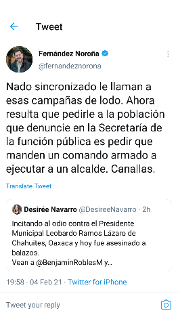
Figure 2 :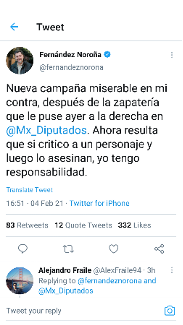
This leads me to think about the mechanisms of co-construction generated by technological devices where I observe the "testimonial image" promoting hatred and violence; and the human actors who participate in the conversation on Twitter. I go ahead to argue that the emergence of a multimedia citizenship also confirms this "participation gap in networked media" (Marwick et al, 2017:11).
III. The desire for visibility in the network society
One wonders how far can technopopulism go in its desire for visibility using Twitter as a strategic device in the digital governmental regime to influence the transformation of social reality? With the hashtag #NoroñaAsesino, traditional media took up the debate generated by the tweets pointing him out as the main person responsible for building hate speech and inciting violence against the municipal president Leobardo Ramos (see figure 3). The main threads of discussion exposed the politician as a promoter of violence (see figure 4):
Figure 3:
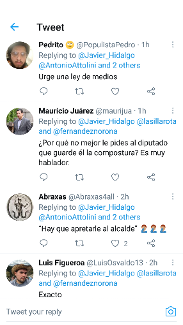
Figure 4 : 
The dissemination of the video on social networks triggered Twitter users, mainly influencer journalists and multimedia citizens, to criticize the words used by federal deputy Fernando Noroña. With the tweets, shared by users, we noticed the rise of a critical multimedia citizenship which reproduces hate subjectivities in diffuse virtual spaces. These text messages on Twitter are news denunciations. Sometimes, they are fictitious writings of a decontextualized violent event. But what motivated the murder of then-mayor Leobardo Ramos? The citizens who captured the political discourse and disseminated the video of federal deputy Fernando Noroña live in the midst of a social conflict derived from the public questioning of the enrichment and, probably, deviation of economic resources by the municipal public servant.
The murder of the mayor is interpreted, then, as a strategy of the emerging multimedia citizenry to alert and capture the attention of the traditional media in the framework of a national, even international, public denunciation of the longue durée structural violence affecting this region of the State of Oaxaca. This part of Oaxaca is a geographical area of clashes between criminal groups. The reproduction of the public figure encouraging violence - as expressed by the users of this social network - only served as a pretext to provide visibility to citizens’ eager to express their anger at the fear and terror of the domination policies exercised by organized crime bosses.
Indeed, there is a political discourse linked to violence that is taken up and exploited by tweets and the main generators of public opinion at the national level. A common thread among the complainants is to point to Fernando Noroña as the main person responsible for influencing the criminals to assassinate the mayor four days after his visit to the municipality of Chahuites.
If the objective was to activate a desire for visibility with his political discourse, he succeeded, not only in boosting the rise of a critical multimedia citizenry, but also in demonstrating the limits of public communication in rural areas with an extreme violence alert derived from the presence of political actors linked to organized crime. The assassination of the mayor acquires a political symbol of the desire for visibility through the incitement to violence by means of political discourse.
As Andrés Monroy-Hernández, Emre Kiciman, Danah Boyd and Scott Counts (2012) suggest, Twitter, as a new news producer, relates an imagined socio-virtual community, which places armed conflicts as security crises which are part of “everyday life". However, multimedia citizens by introducing information that, in another context, would be interpreted as a "common event", in historical moments of war "can put people's lives at risk" (2012:1).
It took four days for Twitter users to relate the debate around the political place of Fernando Fernández Noroña and the space of violence in electoral campaigns. It is from that date that the tweets recovered during the study period show a common thread of networked actors talking about the impact of the potential of public figures in power and their relationship with this new form of digital governmentality. Hence, there is a transition from virtual reality to the transformation of social reality through the execution of violence. There are two moments of interaction in the debate proposed by users. On the one hand, those who produce information; and on the other, the actor's network represents a community of production of subjectivities that reveal hatred and violence.
IV. Violence in the context of electoral campaigns
The 2021 elections have been categorized as the second most violent social process in Mexico's recent history, with Oaxaca being the third most dangerous state in terms of seeking elected office. According to the Fourth Report on Political Violence in Mexico, before April 2021 there were "476 criminal acts against politicians and candidates, with a balance of 443 victims, 79 of them fatal (12 were women)". Therefore, the figure of "443 global victims is equivalent to an increase of 64% compared to the same period of the 2017-2018 electoral process".
However, the particularity in the case of Chahuites is that it inaugurated a new way of expressing political violence by combining technique and populism in the era of the digital governmental regime from the diffusion of the technopopulist subject. This unofficial execution is contextualized by the presence of organized crime groups and the existence of illegal economies. Indeed, I believe it is mandatory to delve into two lines of investigation in order to understand the relationship between the assassination of the mayor four days after the political speech of the federal deputy and sympathizers of the Partido del Trabajo.
On the one hand, the reaction of the multimedia citizenry at a municipal level was occasioned by the murder of the mayor; on the other hand, the naturalization of extreme violence as ‘normal’ in the social fabric of this locality. That is to say, making the death of a mayor one more figure of the violence suffered by the country in this wave of massacre, horror and fear in Mexican society.
The circulation of the video and the tweets produced by the actors interconnected in the network evidenced the fragility of generating multimedia content aimed at hate and violence as instruments of power in the desire for visibility. Candidates desire visibility by resorting to the inputs that technology and political discourse provide in this regime of digital governmentality. The information that is created has a double trap. First, networked danger and, second, fake news. The combination of both traps in contexts of social tensions derived from the presence of criminal groups linked to drug trafficking complicates the answers to the origin of a murder in an environment of electoral campaigns.
Mentions of "governance" or "democracy" are ever-present in online interactions as a new way of expressing political culture in the regime of digital governmentality. Likewise, I note texts that show concern about the risks of regulating social networks. (see figure 5). In this way, socio-digital relationships are established among the participants on Twitter, thus representing a critical multimedia citizenship against the new traditional government in Mexico. Taking into consideration that after the 2018 electoral results, ideological coalitions were formed that led to installing of left-liberal rational in government institutions:
Figure 5 :
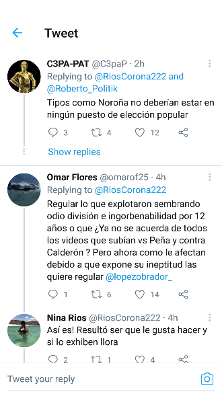
Figure 6:
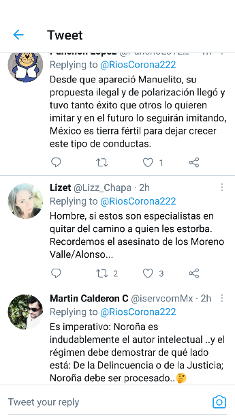
After the 2018 elections, the increase in violence by state agents, and non-state agents, eliminated the reductionist explanation of linking crimes to drug trafficking. Social polarization is also observed in the opinions disseminated in tweets (See figure 6). The limits of technopopulism are the capacity of this emerging multimedia citizenry to turn to virtual spaces such as Twitter and expose the dangerous nature of spreading a message that promotes violence. Therefore, the tweets coincide in pointing out the political discourse as an act of hate against the mayor which had serious consequences on the citizens.
Conclusion
This research note addressed the rise of multimedia citizenship as an actor-network in a new regime of digital governmentality. Thanks to this actor-network, the effects of technopopulism in their desire to gain visibility in the traditional media, but also in the new channels of social networks, became evident. Hence, one of the sections in this paper accounts for the power of audiovisual communities in the production of hate subjectivities and their influence on multimedia citizenship, generating three moments in the activation of violence: the capture of social reality; its transcendence to virtual reality such as Twitter; and, finally, its intervention in the transformation of social reality. The assassination of the mayor of Chahuites would be interpreted as a realization of the popular will in this new regime of digital governmentality. In the face of a crisis of popular representation and political violence, the longue durée structural terror experienced in the daily life of the networked society is added. If the desire is the lack or absence of self-realization, then, in contexts of digital governmentality, the desire is to achieve visibility using violence as a new strategy in political communication. The elimination of the "popular enemy" is a mandate for the self-realization of the true "people".
Final Notes
[1] The history of Chahuites is a transitional one, as it has gone from agrarian conflict to political conflict, and finally to the narco-social conflict of the present. This has led to a reconfiguration of peasant identities in relation to the global economy. Currently, 2,200 hectares of land are dedicated to mango cultivation, and about 15,000 people live in this area (INEGI, 2022).
[2] The objective of this research is not to validate the alleged attitude of the mayor in acts derived from the illicit economy but to understand the behavior and reaction of the multimedia citizenship to a political discourse that foments violence and, as denounced by the tweets, promotes hatred.
[3] For an approximation of the power of social networks in the production of subjectivities through this notion of "testimonial image" see the work of Fabiola Navarro (2016).
[4] For more details on the speech delivered by Congressman Fenando Noroña see: https://bit.ly/3zrvWow
Bibliography
17º. Estudio sobre los Hábitos de los Usuarios de Internet en Mexico. Mayo 2021 (Official Report). Prepared by Asociación de Internet MX available: https://shorturl.at/wENR6
Bickerton, Chris and Invernizzi Accetti, Carlo (2021) “La trampa del tecnopopulismo”. Le Grand Continent. accessed at 1/03/2002 available at https://legrandcontinent.eu/es/2021/04/19/la-trampa-tecnopopulista/
Boyd, danah. (2015). “Social Media: A Phenomenon to be Analyzed.” Social Media + Society 1(1).
Boyd danah, Scott Golder, and Gilad Lotan (2010)."Tweet Tweet Retweet: Conversational Aspects of Retweeting on Twitter." Proceedings of HICSS-42, Persistent Conversation Track. Kauai, HI: IEEE Computer Society. January 5-8, 2010.
Cuarto Informe de Violencia Política en México (Official Report) Prepared by Etellekt, available at https://www.etellekt.com/informe-de-violencia-politica-en-mexico-2021-A30-etellekt.html
De la Torre, Carlos. (2013). El tecnopopulismo de Rafael Correa. ¿Es compatible el carisma con la tecnocracia? Latin American Research Review, 48, 24-43.
DELEUZE G., 2002, « Gilbert Simondon, L’individu et sa genèse physico-biologique », L’île déserte et autres textes. Paris, Minuit, 2002.
Instituto Nacional de Estadística y Geografia (2022).
Marwick, Alice, Claire Fontaine, and danah boyd. (2017). "‘Nobody sees it, nobody gets mad’: Social Media, Privacy, and Personal Responsibility among Low-SES Youth." Social Media and Society, 3(2).
Monroy-Hernández, Andrés, Emre Kiciman, danah boyd, Scott Counts. (2012) “Narcotweets: Social Media in Wartime.” ICWSM’12 poster paper, June 5-7.
Navarro E. Fabiola (2016) “¿Cómo contribuyen las redes sociales en el desarrollo de la subjetividad en sociedades autoritarias? El caso de #YoSoy132 en México”. Observatorio (OBS*) Journal, Media, Internet and Social Movements in the context of asymmetries, 176-201 1646-5954/ERC123483/201617
Rouvroy, Antoinette, et Thomas Berns. « Gouvernementalité algorithmique et perspectives d'émancipation. Le disparate comme condition d'individuation par la relation ? », Réseaux, vol. 177, no. 1, 2013, pp. 163-196.
Rouvroy Antoinette y Bernard Stiegler, « Le régime de vérité numérique », Socio [En ligne], 4 | 2015, mis en ligne le 28 mai 2015, consulté le 09 mars 2022. URL : http://journals.openedition.org/socio/1251 ; DOI : https://doi.org/10.4000/socio.1251
Urbieta Hernández, Roque. El peuple etnofeminista. Movimientos etnopopulistas, mujeres indígenas y violencia política en América Latina (1934-1990). CONfines. Revista de Ciencia Política y Relaciones Internacionales, 2023, Núm. 37, p. 81-101. DOI: https://doi.org/10.46530/cf.vi37/cnfns.n37.p81-101.
Pour citer cet article
Roque Urbieta, « Audiovisual communities as producers of hate subjectivities. Digital Governmentality, technopopulisms and violence in Mexico », RITA, [en ligne], n°16 : 2023, mis en ligne le 1er avril 2024. Disponible en ligne http://www.revue-rita.com/trait-d-union-16/audiovisual-communities-as-producers-of-hate-subjectivities-digital-governmentality-technopopulisms-and-violence-in-mexico-roque-urbieta.html



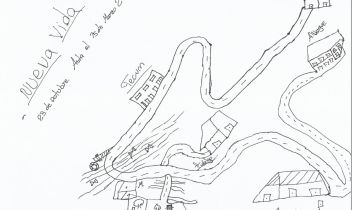
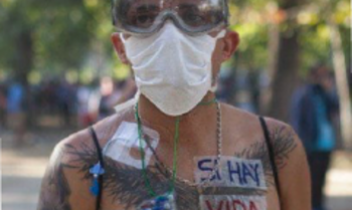
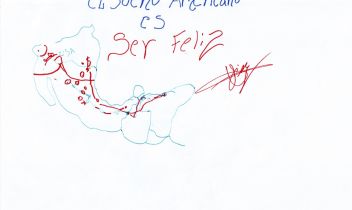
 Avec le soutien du LER-Université Paris 8
Avec le soutien du LER-Université Paris 8